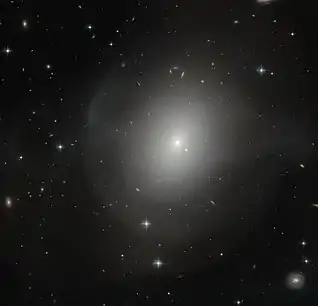NGC 2865
NGC 2865 is an isolated[4] elliptical galaxy in the equatorial constellation of Hydra.[6][7][3] The core region of the galaxy shows a kinematically distinct component showing indications of a recent accretion or merger event that led to a burst of star formation around the nucleus. Observational constraints require this to have occurred within the last 100–400 million years, with the merger most likely being an Sb or Sc-class spiral galaxy.[5]
| NGC 2865 | |
|---|---|
 HST image of NGC 2865 | |
| Observation data (J2000 epoch) | |
| Constellation | Hydra |
| Right ascension | 09h 23m 30.205s[1] |
| Declination | −23° 09′ 41.37″[1] |
| Distance | 110 Mly (35 Mpc)h−1 0.73[2] |
| Apparent magnitude (V) | 11.43[3] |
| Apparent magnitude (B) | 12.18[4] |
| Characteristics | |
| Type | E3-4[5] |
| Other designations | |
| NGC 2865, ESO 498-1, 2MASX J09233020-2309413, PGC 26601 | |
NGC 2865 displays chaotic shell features that are likely the result of an interaction. These shells provide ~11–22% of the galaxy's total luminosity and are generally more blue (younger) than the main galaxy.[5] There is a loop to the northwest and a tail to the southeast of the galaxy, with both being typical of galaxy merger events. Seven HII regions have been identified in the tidal tails, with associated populations of young stars. A ring of neutral hydrogen surrounds the galaxy.[8]
Although there are no nearby galaxies of comparable luminosity, there are a pair of fainter gas-rich galaxies in the vicinity. These lie at angular separations of 6 arcminutes and 9 arcminutes, corresponding to projected separations of 1.0 kpc and 1.5 kpc.[8]
One supernova, SN 2016gwl (type Ia, mag. 15.9), was discovered in NGC 2865 on 2 October, 2016.[9]
References
- Skrutskie, Michael F.; et al. (February 1, 2006). "The Two Micron All Sky Survey (2MASS)". The Astronomical Journal. 131 (2): 1163–1183. Bibcode:2006AJ....131.1163S. doi:10.1086/498708. ISSN 0004-6256. S2CID 18913331.
- Tully, R. Brent; et al. (2016). "Cosmicflows-3". The Astronomical Journal. 152 (2): 21. arXiv:1605.01765. Bibcode:2016AJ....152...50T. doi:10.3847/0004-6256/152/2/50. S2CID 250737862. 50.
- "NGC 2865". SIMBAD. Centre de données astronomiques de Strasbourg. Retrieved 2021-12-13.
- Salinas, R.; et al. (May 2015). "Isolated ellipticals and their globular cluster systems. III. NGC 2271, NGC 2865, NGC 3962, NGC 4240, and IC 4889". Astronomy & Astrophysics. 577: 18. arXiv:1502.06148. Bibcode:2015A&A...577A..59S. doi:10.1051/0004-6361/201425574. S2CID 59021544. A59.
- Hau, G. K. T.; et al. (June 1999). "The shell elliptical galaxy NGC 2865: evolutionary population synthesis of a kinematically distinct core". Monthly Notices of the Royal Astronomical Society. 306 (2): 437–460. arXiv:astro-ph/9902170. Bibcode:1999MNRAS.306..437H. doi:10.1046/j.1365-8711.1999.02526.x. S2CID 15155489.
- "Young and dynamic". www.spacetelescope.org. Retrieved 2018-11-03.
- "Hubble Sees Shell Elliptical Galaxy NGC 2865 | Astronomy | Sci-News.com". Breaking Science News | Sci-News.com. Retrieved 2018-11-03.
- Urrutia-Viscarra, F.; et al. (September 2014). "A census of Hα emitters in the intergalactic medium of the NGC 2865 system". Astronomy & Astrophysics. 569: 13. arXiv:1406.3574. Bibcode:2014A&A...569A..97U. doi:10.1051/0004-6361/201323025. S2CID 119267625. A97.
- Transient Name Server entry for SN 2016gwl. Retrieved 24 March 2023.
External links
- "Results for object NGC 2865 (NGC 2865)". NASA/IPAC Extragalactic Database. California Institute of Technology. Retrieved 2021-02-10.
 Media related to NGC 2865 at Wikimedia Commons
Media related to NGC 2865 at Wikimedia Commons- NGC 2865 on WikiSky: DSS2, SDSS, GALEX, IRAS, Hydrogen α, X-Ray, Astrophoto, Sky Map, Articles and images